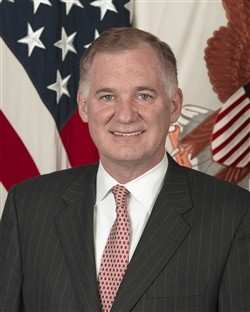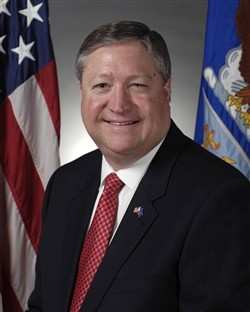Military Needs And Value For Taxpayers At The Heart Of The New
Draft RFP
 Deputy Defense Secretary William J. Lynn, Air Force Secretary
Michael B. Donley and Ashton B. Carter, defense undersecretary for
acquisition, technology and logistics, briefed the Pentagon press
Wednesday on the latest draft RFP to replace the Air Force's aging
KC-135R tanker fleet.
Deputy Defense Secretary William J. Lynn, Air Force Secretary
Michael B. Donley and Ashton B. Carter, defense undersecretary for
acquisition, technology and logistics, briefed the Pentagon press
Wednesday on the latest draft RFP to replace the Air Force's aging
KC-135R tanker fleet.
This is the second time the contract has been competed. The
Government Accountability Office, the investigative arm of
Congress, recommended that the Air Force re-bid the contract -
originally won by a Northrop-Grumman/EADS/Airbus consortium in
February 2008. Boeing protested the decision, and in June 2008 the
GAO agreed that there were irregularities in the contracting
process.
The GAO said the previous process for selecting a winner was too
subjective. DoD took this to heart, and officials stressed this
draft RFP is not a rerun of the last competition. "This time we
will be crystal clear about what we want and what the bidders need
to do to win," Lynn said.
Price is important in the competition, but it will not be the
only factor, Lynn said. "First of all, we'll look at price from a
broad perspective, not just acquisition cost," he said. "We're
going to include certain aspects of life-cycle cost, in particular
fuel burn and military construction; and we're going to look at
non-price factors, particularly how each aircraft that the
companies might bid would meet warfighting requirements."
DoD and Air Force officials worked closely together to ensure
the process this time will be fair, open and transparent. Air Force
and DoD officials developed the source selection strategy and it
has been approved by Defense Secretary Robert M. Gates. "The Air
Force source selection authority will execute this strategy," Lynn
said.

William Lynn
The warfighter requirements - devised by Air Mobility Command -
for the tanker fleet have not changed since the last procurement
try. "But the warfighter has specified which requirements are
necessary for the tanker to 'go to war on Day 1,'" he said. These
requirements are on an acceptable/not acceptable basis, he said.
The team has also identified capabilities that would provide some
additional value, but are not mandatory.
The buy is for 179 aircraft valued at around $35 billion. If all
goes as planned the contract could be awarded next summer. The
draft RFP was released Thursday. It will be a fixed-price incentive
contract in the development phase, and the first five production
lots will be a firm fixed-price contract. The remaining production
will be a not-to-exceed contract. "This is going to constrain
prices considerably, we believe," Lynn said. "It's shifting the
department from a cost-plus world more towards a fixed-price world,
and we think that that's going to be an important element in
avoiding cost overruns."
Air Force Secretary Donley said the newest KC-135R entered the
Air Force in 1964. The first production model of whatever aircraft
is selected would enter the force in 2015 with an initial operating
capability set for 2017.

Michael Donley
Donley said the defense and Air Force teams reviewed the 808
requirements in the previous RFP. "We conducted extensive reviews
of the requirements, eliminating duplication, refining definitions,
combining where appropriate and ensuring all requirements were
measurable," Donley said. The draft RFP has 373 mandatory
requirements. Still there is some value in non-mandatory
capabilities, and Donley said the team identified 93 of these
added-value capabilities and assigned points to them.
The defense officials said they want to make the selection
process as objective as possible. The RFP spells out exactly what
warfighting capabilities are needed, but also details what
efficiencies are desired, said Undersecretary Carter. To test
warfighting effectiveness, evaluators fly each of the offeror's
aircraft against he Integrated Fleet Aerial Refueling Assessment
model, Carter said.
The model posits a situation where the United States is
executing several major war plans simultaneously, and tanker demand
is at a peak. The model will answer the question of how many tanker
aircraft are needed to execute these real-world war plans.
But there is another consideration: The cost of ownership,
Carter said. "These are the elements, of the life-cycle cost of the
tanker, that are under the control of the offerors and which
therefore can fairly be used to discriminate the offerors," he
said. "The vendors do determine the aircraft design, which in turn
determines how much fuel they will burn, over the next 40 years,
carrying out the day-to-day tasks."

Ashton Carter
Military construction projects needed to accommodate the
aircraft are also taken under consideration, he said. Costs to
adjust hangars, ramps, taxiways and runways for the aircraft will
be taken into account. "So both wartime effectiveness and peacetime
efficiency we will assess for each aircraft," Carter said. "We will
'dollarize' those assessments and in dollar terms adjust the bid
prices."
Boeing, one of the known bidders in the competition, quickly
released the following statement on the tanker procurement process:
"Our next step is to conduct a detailed review of the document. We
want to understand how requirements will be defined and prioritized
and how the proposals will be evaluated. That information will help
us decide which plane to offer or whether to offer both planes. We
appreciate that there will be frequent, open discussion with the
U.S. Air Force as we go forward. Both the Air Force and the
American taxpayer will benefit from the tanker options we can
offer. Boeing has a KC-7A7 'family of tankers' available to meet
the warfighter's requirements. Whether it's the agile, flexible
767-based tanker or the large 777-based tanker, Boeing will deliver
a combat-ready tanker with maximum capability at the lowest
cost."
 ANN's Daily Aero-Linx (04.16.24)
ANN's Daily Aero-Linx (04.16.24) Aero-News: Quote of the Day (04.16.24)
Aero-News: Quote of the Day (04.16.24) Airborne 04.10.24: SnF24!, A50 Heritage Reveal, HeliCycle!, Montaer MC-01
Airborne 04.10.24: SnF24!, A50 Heritage Reveal, HeliCycle!, Montaer MC-01 Airborne 04.12.24: SnF24!, G100UL Is Here, Holy Micro, Plane Tags
Airborne 04.12.24: SnF24!, G100UL Is Here, Holy Micro, Plane Tags Airborne-Flight Training 04.17.24: Feds Need Controllers, Spirit Delay, Redbird
Airborne-Flight Training 04.17.24: Feds Need Controllers, Spirit Delay, Redbird






